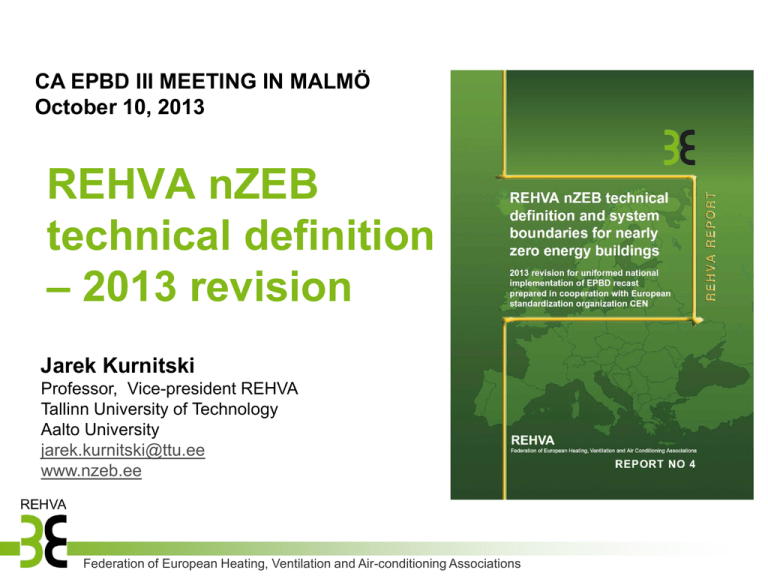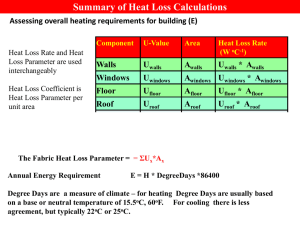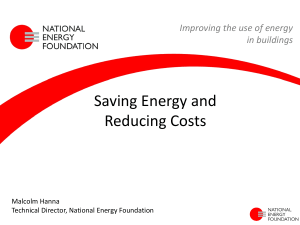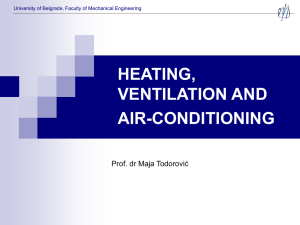REHVA nZEB definition 2013
advertisement

CA EPBD III MEETING IN MALMÖ October 10, 2013 REHVA nZEB technical definition – 2013 revision Jarek Kurnitski Professor, Vice-president REHVA Tallinn University of Technology Aalto University jarek.kurnitski@ttu.ee www.nzeb.ee Federation of European Heating, Ventilation and Air-conditioning Associations Presentation outline 1. REHVA nZEB technical definition 2. Implementation – some national examples Federation of European Heating, Ventilation and Air-conditioning Associations REHVA nZEB definition 2013 • Is intended to help the experts in the Member States in defining the nearly zero energy buildings in a uniform way – so that local conditions are taken into account, but the uniform methodology used • Proposes a technical definition for nZEB buildings following EPBD recast and Cost-optimal regulation • Provides energy calculation framework and system boundaries associated with the definition, prepared in the level of detail to be suitable for the implementation in national building codes for the primary energy and renewable energy ratio indicators’ calculation Federation of European Heating, Ventilation and Air-conditioning Associations EPBD recast established targets for cost optimal and nZEB • EPBD recast (2010/31/EU) requires that energy performance minimum requirements are to be set with a view to achieving cost optimal levels using a comparative methodology framework established by the Commission: - Cost optimal performance level is defined as the energy performance in terms of primary energy leading to minimum life cycle cost • EPBD recast established the target of nearly zero energy buildings (nZEB) for all new buildings (Article 9): - By 31 Dec 2020, all new buildings are nearly zero energy buildings - After 31 Dec 2018, public authorities that occupy and own a new building shall ensure that the building is a nearly zero energy building http://ec.europa.eu/energy/efficiency/buildings/buildings_en.htm http://eur-lex.europa.eu/LexUriServ/LexUriServ.do?uri=OJ:L:2012:081:0018:0036:EN:PDF Federation of European Heating, Ventilation and Air-conditioning Associations EPBD recast – Nearly zero energy buildings nZEB • In the directive ‘nearly zero-energy building’ means a building that has a very high energy performance. The nearly zero or very low amount of energy required should be covered to a very significant extent by energy from renewable sources, including energy from renewable sources produced on-site or nearby. nZEB = very high energy performance + on-site renewables • Definition of “a very high energy performance“ and “significant extent of renewables” let for Member States Federation of European Heating, Ventilation and Air-conditioning Associations EPBD definition for energy performance EPBD definitions (article 2): • ‘energy performance of a building’ means the calculated or measured amount of energy needed to meet the energy demand associated with a typical use of the building, which includes, inter alia, energy used for heating, cooling, ventilation, hot water and lighting Other services may or may not be included in the rating – included in REHVA definition Federation of European Heating, Ventilation and Air-conditioning Associations Energy flows to be covered by nZEB definition for EPP calculation Primary energy indicator EPP EP EPP i Anet E del ,i For thermal and electrical energy it applies: Delivered – exported energy = energy use – on site renewable Federation of European Heating, Ventilation and Air-conditioning Associations f del ,i Eexp,i f exp,i i Anet Some most debated questions in the preparation of nZEB definition • The order of demand reduction and RES measures? – Equal treatment – may be decided on cost optimal bases (on site renewable energy is inside the system boundary, i.e. is directly subtracted from energy use) – Was confirmed in the EC’s Cost-optimal regulations (No 244/2012). Quote: “the RES-based active technologies enter into direct competition with demand-side solutions, which is in line with the purpose and intention of the cost optimal calculation to identify the solution that represents the least global costs without discriminating against or favouring a certain technology.” • Which primary energy factors are to be used? The development of national factors: – EC’s Cost-optimal regulations requires the use of non-renewable primary energy in the cost optimality assessment – (in reality, national factors include energy policy, e.g. for renewable fuels often in between of the total and non-renewable) Federation of European Heating, Ventilation and Air-conditioning Associations REHVA nZEB definition 2013 net zero energy building (net ZEB) Non-renewable primary energy of 0 kWh/(m2 a). net ZEB has exact performance level of 0 kWh/(m2 a) primary energy NOTE A net ZEB is typically a grid connected building with very high energy performance. A net ZEB balances its primary energy use so that the primary energy feed-in to the grid or other energy network equals to the primary energy delivered to ZEB from energy networks. Annual balance of 0 kWh/(m 2 a) primary energy use typically leads to the situation where significant amount of the on-site energy generation will be exchanged with the grid. nearly zero energy building (nZEB) Technically and reasonably achievable national energy use of > 0 kWh/(m2 a) but no more than a national limit value of non-renewable primary energy, achieved with a combination of best practice energy efficiency measures and renewable energy technologies which may or may not be cost optimal. NOTE 1 ‘reasonably achievable’ means by comparison with national energy use benchmarks appropriate to the activities served by the building, or any other metric that is deemed appropriate by each EU Member State. NOTE 2. Renewable energy technologies needed in nearly zero energy buildings may or may not be cost-effective, depending on available national financial incentives. nZEB depends on national conditions Federation of European Heating, Ventilation and Air-conditioning Associations nZEB def is based on detailed system boundaries • System boundaries (SB) for energy need, energy use and delivered and exported energy calculation. The last one may be interpreted as the building site boundary. • Demand reduction measures can be distinguished from RE solutions in the energy use SB, not in the delivered/exported energy SB Federation of European Heating, Ventilation and Air-conditioning Associations Example – nZEB Office building • an office building in Paris • a gas boiler for heating with seasonal efficiency of 90% • free cooling from boreholes (about 1/3 of the need) is used and the rest is covered with mechanical cooling • for borehole cooling, seasonal energy efficiency ratio of 10 is used and for mechanical cooling 3.5 • Ventilation system with specific fan power of 1.2 kW/(m3/s) will use 5.6 kWh/(m2 a) fan energy • a solar PV system providing 15.0 kWh/(m2 a), from which 6.0 is utilized in the building and 9.0 is exported to the grid Federation of European Heating, Ventilation and Air-conditioning Associations Example of nZEB office – primary energy • Electricity use of cooling, ventilation, lighting and appliances is 39.8 kWh/(m2 a) • Solar electricity of 6.0 kWh/(m2 a) reduces the delivered electricity to 33.8 kWh/(m2 a) • Net delivered fuel energy (caloric value) is 4.2 kWh/(m2 a) and primary energy is 54 kWh/(m2 a) Federation of European Heating, Ventilation and Air-conditioning Associations RER system boundary New element in the system boundary • Thermal energy from ambient heat exchangers to be accounted (in the delivered/exported energy calculation calculated with COP) Federation of European Heating, Ventilation and Air-conditioning Associations RER Equation (based on total primary energy) RERP E i E i ren ,i f del ,tot ,i f del ,nren ,i E del ,i i ren ,i E del ,i f del ,tot ,i Eexp,i f exp,tot ,i i i where RERP is the renewable energy ratio based on the total primary energy, Eren,i is the renewable energy produced on site or nearby for energy carrier i, kWh/a; fdel,tot,i is the total primary energy factor (-) for the delivered energy carrier i; fdel,nren,i is the non-renewable primary energy factor (-) for the delivered energy carrier i; fexp,tot,i is the total primary energy factor (-)of the delivered energy compensated by the exported energy for energy carrier i; Edel,i is the delivered energy on site or nearby for energy carrier i, kWh/a; Eexp,i is the exported energy on site or nearby for energy carrier i, kWh/a. • The renewable energy ratio is calculated relative to all energy use in the building, in terms of total primary energy • Ambient heat sources of heat pumps and free cooling are to be included to the renewable energy use system boundary Federation of European Heating, Ventilation and Air-conditioning Associations RER: Example of nZEB office • The same input data as in previous example Federation of European Heating, Ventilation and Air-conditioning Associations System boundary for nearby RE • System boundary for nearby RE plants contractually linked to the building (a share of the capacity/production can be linked to the building) • National legislation needed to allocate new RE capacity to the building/developement with a long term contract Federation of European Heating, Ventilation and Air-conditioning Associations System boundary for multiple buildings DELIVERED ENERGY Electricity District heat District cooling Building n Fuels (renewable and non-renewable) Building 2 EXPORTED ENERGY Electricity Building 1 SITE ENERGY CENTRE Building site boundary = system boundary of delivered and exported energy Federation of European Heating, Ventilation and Air-conditioning Associations Heating en. Cooling en. Summary: REHVA nZEB 2013 • ZEB, net ZEB, PEB and nZEB definitions • A set of system boundaries to calculate: – Energy need – Energy use – Delivered and exported energy – Primary energy – Renewable energy ratio – Nearby energy production – Sites with multiple buildings • Load matching and grid interactions • Worked examples • National low energy and nZEB requirements/targets from selected countries Federation of European Heating, Ventilation and Air-conditioning Associations Implementation – some national examples Latest updates of regulation – nZEB under preparation: • Germany • Sweden nZEB definitions: • Denmark • Estonia • Norway Federation of European Heating, Ventilation and Air-conditioning Associations Estonia 200 Primary energy, kWh/m2a Towards nZEB: • Roadmap of some countries towards nearly zero energy buildings to improve energy performance of new buildings • Many countries have prepared long term roadmaps with detailed targets • Helps industry to prepare/commit to the targets 150 100 50 0 Federation of European Heating, Ventilation and Air-conditioning Associations 2008 2013 2021 nZEB definitions • European definitions based on EPBD recast: – REHVA 2013 – REHVA has revised its nZEB technical definition and set of system boundaries for primary energy indicator and RER calculation in cooperation with CEN, soon available www.rehva.eu – CEN is working with overarching EPBD standard prEN 15603:2013, which will include calculation bases for primary energy and RER • National definitions – Concerted Action CA EPBD (March 2013 data) has collected detailed information from 19 countries: – of which six have their national application of the nZEB definition included in a legal document (Cyprus, Denmark, Estonia, Lithuania, Slovak Republic and France) – 9 countries Oct 2013 data – six other countries have their application developed, but not yet fixed in a legal document – and the remaining seven countries have documented their current plans Federation of European Heating, Ventilation and Air-conditioning Associations Situation with energy frames • In most of countries, on site renewable energy production is subtracted from delivered energy • Differences in energy frames: – primary energy not yet used in all countries – Some countries (Germany, France) use reference building method, fixed values in other countries – Both simulation (Estonia, Finland) and monthly methods (Germany, Denmark) used • Inclusion of energy flows depends on country: – Germany/residential – heating energy only (space heating, DHW and heating of ventilation air) – Germany/non-residential – cooling and lighting also included (appliances not) – Denmark – appliances and in residential also lighting not included – Sweden – appliances and user’s lighting not included (facility lighting incl.) – Estonia, Finland, Norway – appliances and lighting included (all inclusive) Federation of European Heating, Ventilation and Air-conditioning Associations Energy frames, exported energy • Exported electricity can be taken into account on annual basis (full utilization), monthly bases (limited to the amount of the delivered electricity each month and the rest of exported is not accounted) or is not taken into account • Full utilization (annual bases): – Denmark, Estonia, net plus energy program in Germany • Monthly bases: – Germany, Sweden? (not decided) • Not accounted – Finland, Norway, Italy • Most of energy frames not yet ready to support exported energy Federation of European Heating, Ventilation and Air-conditioning Associations Development of primary energy requirements for heating in Germany Federation of European Heating, Ventilation and Air-conditioning Associations Latest Swedish energy performance requirements on delivered energy Annual delivered energy use for heating, comfort cooling, domestic hot water provision and other shared services in the building (kWh/m2) Climate zone 1 (north Sweden) 2 (middle Sweden) 3 (south Sweden) Residential buildings with heating systems other than electric heating 130 110 90 Residential buildings with electric heating 95 75 55 120 + Commercial and similar premises with heating systems other than electric heating 110 x (q − 0,35) 95 + Commercial and similar premises with electric heating 65 x (q − 0,35) 110 + 90 x (q − 0,35) 75 + 55 x (q − 0,35) 80 + 70 x (q − 0,35) 55 + 45 x (q − 0,35) • Requirements for delivered energy use from the 1st of Jan 2013 • Previous building codes 2006 and 2009, nZEB definition 2015 Federation of European Heating, Ventilation and Air-conditioning Associations Towards nearly zero energy buildings Denmark Characteristic values Maximum of primary energy to Residential buildings (houses, hotels, etc.) Non-residential buildings (offices, schools, institutions and other buildings) Conversion factors Electricity District heating Energy frame 2010 Energy frame 2015 52.5 + 1650/A in kWh/m²a 71.3 + 1650/A in kWh/m²a 2.5 1.0 30 + 20 1000/A kWh/m²a in kWh/m²a 41 + 25 1000/A kWh/m²a in kWh/m²a 2.5 1.8 0.8 0.6 Federation of European Heating, Ventilation and Air-conditioning Associations Energy frame 2020 Towards nearly zero energy buildings Estonia Primary energy requirements for 9 building types (apply from Jan 9, 2013) nZEB A kWh/(m2 a) Low energy B kWh/(m2 a) Min.req. new Min.req. maj.ren. C (cost opt.) D (cost opt.) kWh/(m2 a) kWh/(m2 a) Detached houses 50 120 160 210 Apartment buildings 100 120 150 180 Office buildings 100 130 160 210 • nZEB and low energy requirements officially given (not yet mandatory) • Conversion factors: – Electricity 2.0 – Fossil fuels 1.0 – District heat 0.9 – Renewable fuels 0.75 Federation of European Heating, Ventilation and Air-conditioning Associations Towards nearly zero energy buildings Norway Energy frame [kWh/m²y] Building Code TEK07 TEK10 TEK15 - Passive house Residential 135 (detached house) Residential (office) TEK25 TEK30 nearly ZEB Intermediate Net ZEB 130 80 120 115 (Heating: 15, Cooling: 0, DHW: 30) 165 150 75* (apartment block) Non-residential TEK20 (Heating: 20, Cooling: 10, DHW: 5) * the low value is largely due to improvement in electrical appliances and adoption of demand controlled lighting and ventilation, on top of envelope improvements. Furthermore, the low amount of hot water required in offices makes the total energy need lower than for residential units. • Requirements for energy need for 13 building types • Energy balance is between energy need and delivered energy (generation not included, HVAC-electricity and cooling included) • All inclusive energy frame (appliances, lighting and cooling included) • nZEB definition under development Federation of European Heating, Ventilation and Air-conditioning Associations How to compare min. requirements? Detached house (CLIMA 2013 data) • Recalculation from primary energy to delivered energy needed, which can be compared in all countries • The figure shows maximum allowed delivered energy without household electricity (i.e. delivered energy to heating, hot water and ventilation systems) in each country for fossil fuel or electrical heating Oil or gas boiler Electrical heating 100 Max delivered energy, kWh/(m2a) • 150 m2 detached house considered • Degree-day correction (base 17°C) to Copenhagen, energy use for hot water heating 25 kWh/(m2a) 120 80 60 40 20 0 Denmark Norway Federation of European Heating, Ventilation and Air-conditioning Associations Sweden Estonia Finland Apartment and office buildings with district heating 140 Apartment building Office building Max delivered energy, kWh/(m2a) 120 100 80 60 40 20 0 Denmark • Norway Sweden Estonia Finland Maximum allowed delivered energy for heating, hot water and ventilation systems in apartment buildings and for office buildings (lighting included) with district heating Federation of European Heating, Ventilation and Air-conditioning Associations







